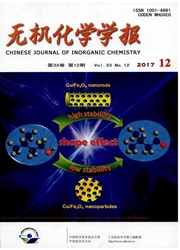

 中文摘要:
中文摘要:
为探讨单齿/双齿吡啶类配体对反应平衡的影响,在模拟生理条件下(0.15mol·L^-1NaCl溶液),应用多核(1H、13C和51V)多维(COSY,HSQC和HMBC)以及变温NMR技术研究双过氧钒配合物[OV(O2)2(D2O)]-/[OV(O2)2(HOD)]-(简写为bpV)与系列吡啶类配体的相互作用,研究结果表明bpV与有机配体的反应性从强到弱的顺序为:2,2′-联吡啶〉2,2′-联吡啶-4,4′-二甲酸根〉吡啶〉异烟酸根,这说明双齿吡啶类配体配位能力强于单齿配体,而不带羧基的吡啶类配体(单齿或双齿)配位能力强于所对应的带羧基的取代吡啶,竞争配位导致一系列新的6配位(配体为吡啶或异烟酸根)或7配位(配体为2,2′-联吡啶或2,2′-联吡啶-4,4′-二甲酸根)的过氧钒物种[OV(O2)2LL′]n-(LL′=吡啶类配体,n=1,2,3)生成。
 英文摘要:
英文摘要:
To understand how the monodentate/bidentate pyridine-like ligands affect the reaction equilibrium, the interactions between diperoxovanadate complex [OV (O2)2(D2O)]-/[OV (O2)2(HOD)]-(abbr. bpV) and a series of pyridine-like ligands in solution were explored using multinuclear (1H, 13C, and 51V) magnetic resonance, COSY, HSQC, HMBC, and variable temperature NMR in 0.15 mol·L^-1 NaCl ionic medium for mimicking the physiological condition. The reactivity among these organic ligands and bpV are 2,2′-bipyridine 4,4′-dicarboxylate-2,2′-bipyridine pyridine isonicotinate. The experimental results indicated that the coordinating ability of bidentate ligands is stronger than that of monodentate ligands, and the coordinating ability of unsubstituted ligands is stronger than that of corresponding carboxylate substituted ligands. The competitive coordination results in the formation of a series of new six-coordinated (pyridine or isonicotinate) or seven-coordinated (2,2′-bipyridine or 4,4′-dicarboxylate-2,2′-bipyridine) peroxovanadate species [OV(O2)2LL′]n-(LL′= pyridine-like ligands, n=1, 2, 3).
 同期刊论文项目
同期刊论文项目
 同项目期刊论文
同项目期刊论文
 Simultaneous electrochemical determination of hydroquinone and catechol at mwnts and cobalt(ii) tetr
Simultaneous electrochemical determination of hydroquinone and catechol at mwnts and cobalt(ii) tetr Synthesis of Novel Trispiroheterocycles through 1,3-Dipolar Cycloaddition of Azomethine Ylides and N
Synthesis of Novel Trispiroheterocycles through 1,3-Dipolar Cycloaddition of Azomethine Ylides and N Synthesis of Spiro Thiazolo[3,2-a]pyrimidine Compounds by One-Pot Sequential 1,3-Dipolar Cycloadditi
Synthesis of Spiro Thiazolo[3,2-a]pyrimidine Compounds by One-Pot Sequential 1,3-Dipolar Cycloadditi Unexpected 1,3-Dipolar Cycloaddition Reaction of Thiazolo[3,2-a]pyrimidine Derivatives and Nitrilimi
Unexpected 1,3-Dipolar Cycloaddition Reaction of Thiazolo[3,2-a]pyrimidine Derivatives and Nitrilimi Synthesis of Novel Spiro Thiazolo[3,2-a][1,3,5]triazines via 1,3-Dipolar Cycloaddition of Azomethine
Synthesis of Novel Spiro Thiazolo[3,2-a][1,3,5]triazines via 1,3-Dipolar Cycloaddition of Azomethine Fabrication of poly (2,6-pyridinedicarboxylic acid)/MWNTs modified electrode for simultaneous determ
Fabrication of poly (2,6-pyridinedicarboxylic acid)/MWNTs modified electrode for simultaneous determ Direct electrochemical reduction of graphene oxide and its application to determination of L-tryptop
Direct electrochemical reduction of graphene oxide and its application to determination of L-tryptop NMR and theoretical study on interactions between diperoxovanadate complex and pyrazole-like ligands
NMR and theoretical study on interactions between diperoxovanadate complex and pyrazole-like ligands Synthesis of Dispiro[oxindole-pyrrolidine]-thiazolo[3,2-a][1,3,5]triazines by 1,3-Dipolar Cycloaddit
Synthesis of Dispiro[oxindole-pyrrolidine]-thiazolo[3,2-a][1,3,5]triazines by 1,3-Dipolar Cycloaddit Spectroscopic investigation on the intermolecular interaction between N-confused porphyrins-(3-methy
Spectroscopic investigation on the intermolecular interaction between N-confused porphyrins-(3-methy 1,3-Dipolar Cycloaddition of 2,6-Dichlorobenzonitrile Oxide to 2-Methyl-N-confused Porphyrin. Regio-
1,3-Dipolar Cycloaddition of 2,6-Dichlorobenzonitrile Oxide to 2-Methyl-N-confused Porphyrin. Regio- Synthesis of Novel Spiro Thiazolotriazole Derivatives via 1,3-Dipolar Cycloaddition of Azomethine Yl
Synthesis of Novel Spiro Thiazolotriazole Derivatives via 1,3-Dipolar Cycloaddition of Azomethine Yl DDQ-Supported Alkoxylation of 2-Aza-21-carbaporphyrin and Noncatalyzed Transetherification of Its 3,
DDQ-Supported Alkoxylation of 2-Aza-21-carbaporphyrin and Noncatalyzed Transetherification of Its 3, Investigation of the Interaction Between N-benzyl Piperidones and Bovine Serum Albumin by Spectrosco
Investigation of the Interaction Between N-benzyl Piperidones and Bovine Serum Albumin by Spectrosco Spectroscopic and theoretical study on the interaction between diperoxovanadate complexes and glycyl
Spectroscopic and theoretical study on the interaction between diperoxovanadate complexes and glycyl Study on the coordination and solution structures for the interaction systems between biperoxidovana
Study on the coordination and solution structures for the interaction systems between biperoxidovana The investigation of the interaction between NCP-EDA and bovine serum albumin by spectroscopic appro
The investigation of the interaction between NCP-EDA and bovine serum albumin by spectroscopic appro The investigation of the interaction between edaravone and bovine serum albumin by spectroscopic app
The investigation of the interaction between edaravone and bovine serum albumin by spectroscopic app Study on the interaction between salvianic acid A sodium and bovine serum albumin by spectroscopic m
Study on the interaction between salvianic acid A sodium and bovine serum albumin by spectroscopic m Study of the interaction between N-confused porphyrin and bovine serum albumin by fluorescence spect
Study of the interaction between N-confused porphyrin and bovine serum albumin by fluorescence spect The fluorescence spectroscopic study on the interaction between imidazo[2,1-b]thiazole analogues and
The fluorescence spectroscopic study on the interaction between imidazo[2,1-b]thiazole analogues and NMR and theoretical study on interactions between diperoxovanadate complex and 4-substituted pyridin
NMR and theoretical study on interactions between diperoxovanadate complex and 4-substituted pyridin Characteristics and nature of the intermolecular interactions between thiophene and XY(X, Y=F,Cl, Br
Characteristics and nature of the intermolecular interactions between thiophene and XY(X, Y=F,Cl, Br Synthesis of N1-Substituted 1,2,3,6-Tetrahydropyrimidin-2-ones via an Unexpected Reaction of Thiazol
Synthesis of N1-Substituted 1,2,3,6-Tetrahydropyrimidin-2-ones via an Unexpected Reaction of Thiazol Synthesis of [1,2,4]Oxadiazolo[4,5-a]thiazolo[2,3-b]pyrimidin-9(10H)-ones via 1,3-Dipolar Cycloaddit
Synthesis of [1,2,4]Oxadiazolo[4,5-a]thiazolo[2,3-b]pyrimidin-9(10H)-ones via 1,3-Dipolar Cycloaddit Spectroscopic studies on the interactions between 3,4-dihydropyrimidin-2(1H)-ones and bovine serum a
Spectroscopic studies on the interactions between 3,4-dihydropyrimidin-2(1H)-ones and bovine serum a Synthesis of Trispiro[oxindole-pyrrolidine]-cyclopentanone-isoxazolines by 1,3-Dipolar Cycloaddition
Synthesis of Trispiro[oxindole-pyrrolidine]-cyclopentanone-isoxazolines by 1,3-Dipolar Cycloaddition Spectroscopic investigation of the interaction between diperoxovanadate complexes and benzimidazole-
Spectroscopic investigation of the interaction between diperoxovanadate complexes and benzimidazole- Label-free optical biosensor based on localized surface plasmon resonance of immobilized gold nanoro
Label-free optical biosensor based on localized surface plasmon resonance of immobilized gold nanoro Study on the interaction between dihydromyricetin and bovine serum albumin by spectroscopic techniqu
Study on the interaction between dihydromyricetin and bovine serum albumin by spectroscopic techniqu 期刊信息
期刊信息
